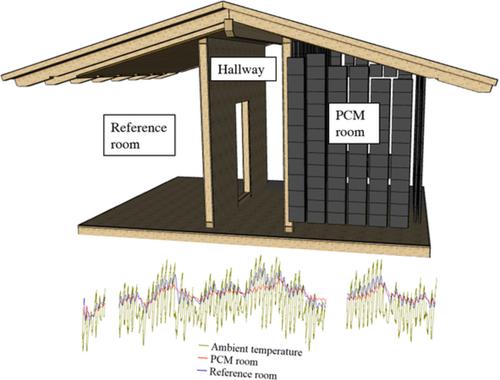当前位置:
X-MOL 学术
›
Int. J. Energy Res.
›
论文详情
Our official English website, www.x-mol.net, welcomes your
feedback! (Note: you will need to create a separate account there.)
Passive room conditioning using phase change materials-Demonstration of a long-term real size experiment
International Journal of Energy Research ( IF 4.3 ) Pub Date : 2020-04-01 , DOI: 10.1002/er.5406 Sebastian Sonnick 1, 2 , Lars Erlbeck 1 , Maximilian Gaedtke 2, 3 , Frederik Wunder 1 , Christoph Mayer 4 , Mathias J. Krause 2, 3 , Hermann Nirschl 2 , Matthias Rädle 1
International Journal of Energy Research ( IF 4.3 ) Pub Date : 2020-04-01 , DOI: 10.1002/er.5406 Sebastian Sonnick 1, 2 , Lars Erlbeck 1 , Maximilian Gaedtke 2, 3 , Frederik Wunder 1 , Christoph Mayer 4 , Mathias J. Krause 2, 3 , Hermann Nirschl 2 , Matthias Rädle 1
Affiliation

|
The thermal properties of lightweight buildings can be efficiently improved by using phase change materials (PCMs). The heat storage capacity of the building can be extended exactly at the desired temperature level, which leads to an enormous increase in residential comfort. This is shown in the present paper using the example of a prefabricated wooden house. The house was divided into two identical rooms. One of them was equipped with almost one ton of phase change material based on salt hydrates with a melting temperature of approx. 21°C. The material was encapsulated in 1-l Polyethylene containers and installed in two back-ventilated layers inside of the walls. The house was monitored for a period of 87 days in terms of temperatures, solar radiation and air velocity inside the PCM wall system. A considerable temperature buffering could be observed in the PCM room compared to the reference room. An overall reduction of the temperature fluctuations of 57% and a reduction of the day/night fluctuations of 62% compared to the reference room could be obtained. In addition, a prediction regarding the energy demand of such buildings is discussed on the basis of a simulation program. Thus, the annual cooling capacity can be reduced by 36.5% compared to the regular timber construction technique by introducing PCM. Furthermore, the good correlation of the simulation results with the experimental ones allows using the simulation as a tool to design a house with additional thermal storages.
中文翻译:

使用相变材料的被动房间调节-长期实际尺寸实验的演示
使用相变材料 (PCM) 可以有效改善轻型建筑的热性能。建筑物的蓄热能力可以在所需的温度水平下精确扩展,从而极大地提高居住舒适度。本文以预制木屋为例说明了这一点。房子被分成两个相同的房间。其中一个配备了近一吨基于盐水合物的相变材料,熔化温度约为 21°C。该材料被封装在 1-l 聚乙烯容器中,并安装在墙壁内部的两个背通风层中。该房屋在 PCM 墙系统内的温度、太阳辐射和空气流速方面受到了为期 87 天的监测。与参考房间相比,在 PCM 房间中可以观察到相当大的温度缓冲。与参考房间相比,温度波动总体减少了 57%,昼夜波动减少了 62%。此外,在模拟程序的基础上讨论了有关此类建筑物能源需求的预测。因此,通过引入 PCM,与常规木结构技术相比,年制冷量可降低 36.5%。此外,模拟结果与实验结果的良好相关性允许使用模拟作为工具来设计带有额外蓄热装置的房屋。与参考房间相比,温度波动总体减少了 57%,昼夜波动减少了 62%。此外,在模拟程序的基础上讨论了有关此类建筑物能源需求的预测。因此,通过引入 PCM,与常规木结构技术相比,年制冷量可降低 36.5%。此外,模拟结果与实验结果的良好相关性允许使用模拟作为工具来设计带有额外蓄热装置的房屋。与参考房间相比,温度波动总体减少了 57%,昼夜波动减少了 62%。此外,在模拟程序的基础上讨论了有关此类建筑物能源需求的预测。因此,通过引入 PCM,与常规木结构技术相比,年制冷量可降低 36.5%。此外,模拟结果与实验结果的良好相关性允许使用模拟作为工具来设计带有额外蓄热装置的房屋。与引入 PCM 的常规木结构技术相比,5%。此外,模拟结果与实验结果的良好相关性允许使用模拟作为工具来设计带有额外蓄热装置的房屋。与引入 PCM 的常规木结构技术相比,5%。此外,模拟结果与实验结果的良好相关性允许使用模拟作为工具来设计带有额外蓄热装置的房屋。
更新日期:2020-04-01
中文翻译:

使用相变材料的被动房间调节-长期实际尺寸实验的演示
使用相变材料 (PCM) 可以有效改善轻型建筑的热性能。建筑物的蓄热能力可以在所需的温度水平下精确扩展,从而极大地提高居住舒适度。本文以预制木屋为例说明了这一点。房子被分成两个相同的房间。其中一个配备了近一吨基于盐水合物的相变材料,熔化温度约为 21°C。该材料被封装在 1-l 聚乙烯容器中,并安装在墙壁内部的两个背通风层中。该房屋在 PCM 墙系统内的温度、太阳辐射和空气流速方面受到了为期 87 天的监测。与参考房间相比,在 PCM 房间中可以观察到相当大的温度缓冲。与参考房间相比,温度波动总体减少了 57%,昼夜波动减少了 62%。此外,在模拟程序的基础上讨论了有关此类建筑物能源需求的预测。因此,通过引入 PCM,与常规木结构技术相比,年制冷量可降低 36.5%。此外,模拟结果与实验结果的良好相关性允许使用模拟作为工具来设计带有额外蓄热装置的房屋。与参考房间相比,温度波动总体减少了 57%,昼夜波动减少了 62%。此外,在模拟程序的基础上讨论了有关此类建筑物能源需求的预测。因此,通过引入 PCM,与常规木结构技术相比,年制冷量可降低 36.5%。此外,模拟结果与实验结果的良好相关性允许使用模拟作为工具来设计带有额外蓄热装置的房屋。与参考房间相比,温度波动总体减少了 57%,昼夜波动减少了 62%。此外,在模拟程序的基础上讨论了有关此类建筑物能源需求的预测。因此,通过引入 PCM,与常规木结构技术相比,年制冷量可降低 36.5%。此外,模拟结果与实验结果的良好相关性允许使用模拟作为工具来设计带有额外蓄热装置的房屋。与引入 PCM 的常规木结构技术相比,5%。此外,模拟结果与实验结果的良好相关性允许使用模拟作为工具来设计带有额外蓄热装置的房屋。与引入 PCM 的常规木结构技术相比,5%。此外,模拟结果与实验结果的良好相关性允许使用模拟作为工具来设计带有额外蓄热装置的房屋。











































 京公网安备 11010802027423号
京公网安备 11010802027423号